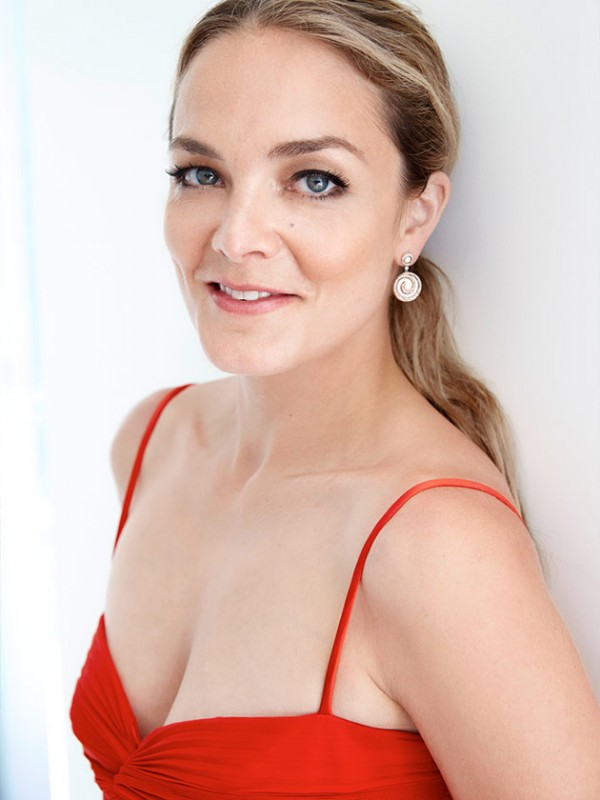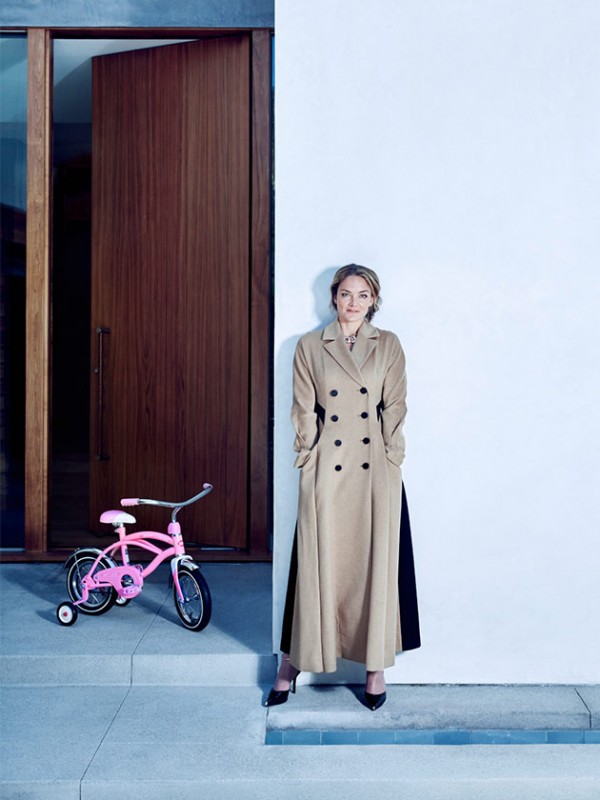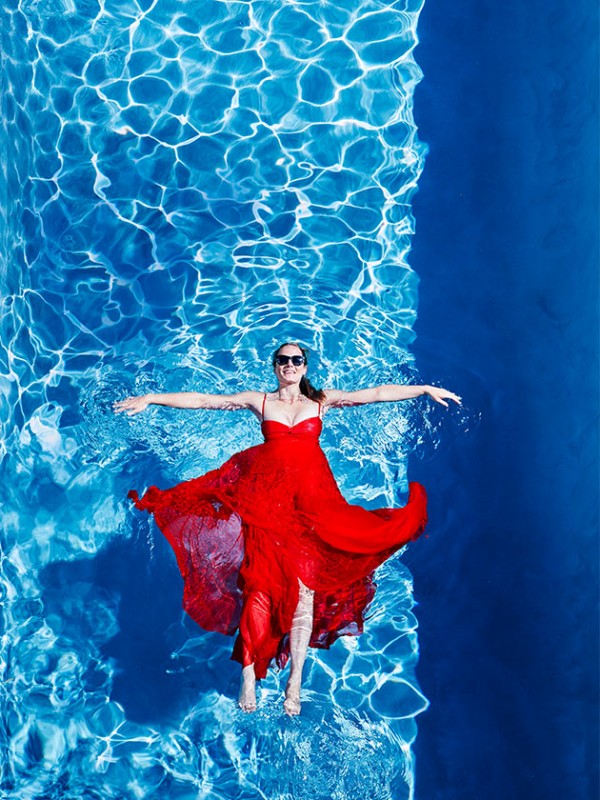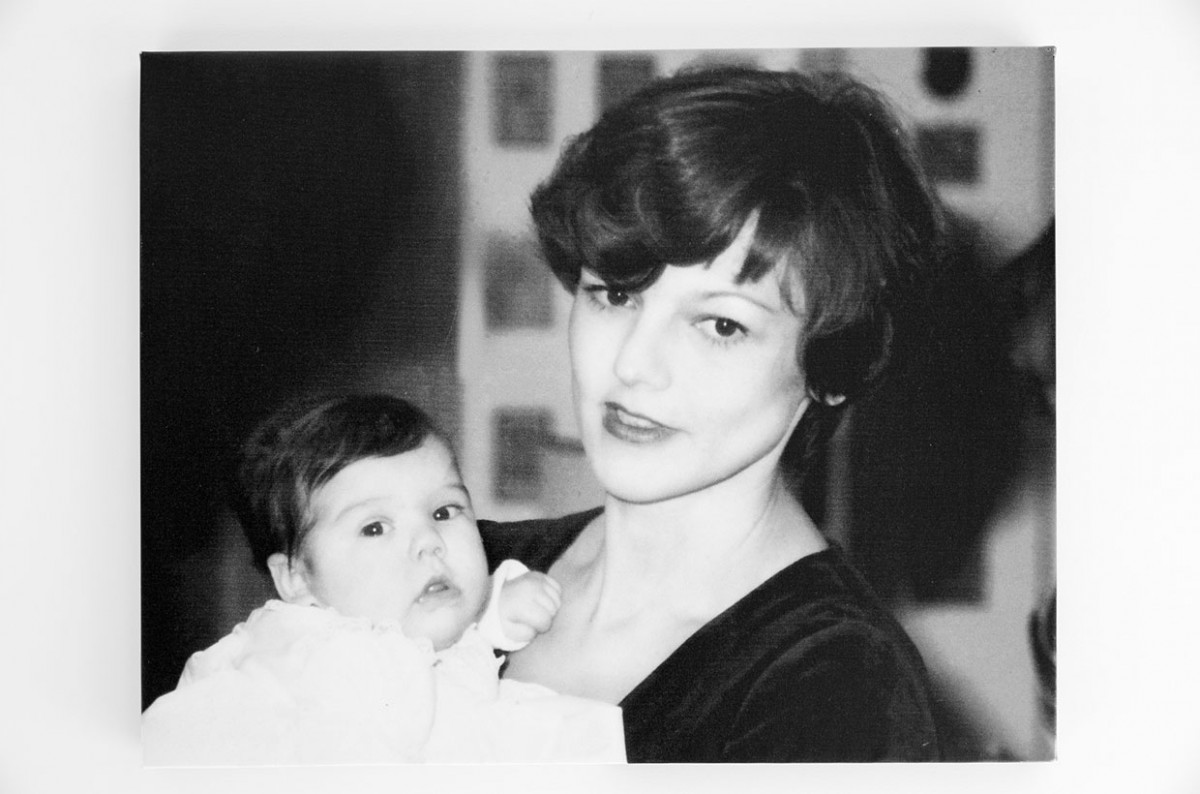A Modern Heroine by Michaela Cordes | 27th November, 2015 | Personalities
When her mother developed blood cancer 25 years ago, her father founded DKMS – the German Bone Marrow Donor Center. Escaping her grief, Katharina Harf, just a teenager at the time, threw herself into an elite education that eventually led her via Harvard to her true calling. As international DKMS ambassador and co-founder of DKMS USA, the young mother fights for blood cancer patients worldwide, and for 13 years, has been devoted to the cause of the non-profit organization which has become the largest stem cell donor center in the world.
The Greenwich Hotel in New York City. Katharina Harf is just finishing up a meeting on the sunny patio. Suddenly, Bradley Cooper rushes by and sits down at another table. Most of the ladies turn their heads, gazing at the handsome actor. Except for Katharina, who wants him too, but as a supporter for DKMS. “Are you interested in saving lives?” she asks when a mutual friend introduces them. Katharina: “He smiled and answered: ‘How can I help?’” Just a few weeks later, the Hollywood star is sitting in front of the cameras for ABC, one of the biggest TV networks in the country, explaining DKMS’s mission on “Good Morning America,” the biggest morning show in the USA. 4.6 million viewers watch as the Hollywood star introduces the man sitting next to him on the TV couch: Anthony Daniels, a 29-year-old athlete suffering from Hodgkin’s lymphoma, who is
urgently seeking a stem cell donor since his cancer has returned for the fourth time. On the very same day, 4,000 volunteer donors register with the U.S. branch of DKMS in response to the actor’s appeal.
“Through my work I keep my mother alive.” Katharina Harf
“That was an incredible moment!,” says Katharina Harf, still visibly moved by the huge number of newly registered stem cell donors. With unswerving commitment, irresistible charm and creative ideas, the young mother has been fighting for blood cancer patients in urgent need of a stem cell transplant for more than 13 years now. Having first taken the organization from Germany to the USA, she now travels the world as an international DKMS ambassador for the non-profit organization. “Getting famous people interested in our cause and consequently engage in our fight against blood cancer is by no means easy. But once they understand that they can help us save lives, most of them are happy to support us.” Making contacts, collecting funds, raising awareness in foreign countries is what the remarkable lifesaver does with a passion she has learned from her father, the successful entrepreneur Peter Harf. “It all started with what happened to my mother, who died of blood cancer 24 years ago,” Katharina tells me over a cappuccino on the same patio in Tribeca, her expression suddenly pensive. “I remember it as if it were yesterday. I was a very shy, 14-year-old teenager when my mother became ill with cancer at the age of 45. And I’ll never forget how my father continued to make her feel like the most beautiful woman in the world, even when she lost her hair. My parents had known each other since dancing school. They were 16 when they met. We were spending our summer vacation in Greece when my mother realized something was wrong. She was pale despite the intense sunshine, had a slightly raised temperature the whole time and had bruises all over her body – which in itself is a sign of poor blood levels.”
According to DKMS, every year, more than 917,000 people all over the world are diagnosed with blood cancer. DKMS looks for stem cell donors and matches them with people whose treatment requires a stem cell transplant. Most patients are suffering from blood cancer or other diseases of the hematopoietic system. With more than 5.5 million registered donors and more than 50,000 stem cell transplants, DKMS is the biggest stem cell donor center in the world and currently operates branches in Germany, the United States, Poland, Spain and Great Britain. Blood cancer patients can often only beat the disease with the help of stem cells from an unrelated, matching donor. Only one third of all patients find their genetic twin within their own family. The probability of finding a matching donor outside the family is between one in 20,000 and one in several million. Every fifth blood cancer patient still needs a matching donor.
“When my mother died there were 3,000 donors, today five million are registered with DKMS all over the world.” Katharina Harf
“That was my mother’s situation at the time. In the beginning she was fine after the chemotherapy, but then she had a relapse and there was only one thing that could help her: a bone marrow transplant. Although she had six siblings, none of them was her genetic twin. The only solution was to find a donor outside the family. It was this desperate situation that led to the foundation of DKMS. Twenty-four years ago, there were only 3,000 registered stem cell donors in the whole of Germany.”
Peter Harf drummed up support from friends, doctors and family, launched donor drives across Germany in cities like Frankfurt, Cologne and Berlin and succeeded in activating no fewer than 68,000 unrelated donors within one year.
“It wasn’t an easy time for my older sister Viktoria and me. Partly because our pictures were on all the flyers for the donor drives, we were appearing on TV and our story became public knowledge. But my mother turned into a very strong person as a result of her illness – that’s something I’ve seen in a lot of patients since; she never showed any sign of weakness when we kids were around.”
But after a battle of over 12 months, Mechthild Harf passed away. “My father had to promise my mother that he would keep fighting for all the other patients all over the world that were in need of stem cells.” In the years that followed, DKMS went on to establish itself as an institution in Germany. Meanwhile Katharina Harf – just 15 years old at the time – moved from Frankfurt to New York with her father, grandparents and sister and proceeded to throw herself into an elite education. “I’d always been very ambitious, even as a small child. First I went to boarding school, Exeter Academy in New Hampshire, and then on to Harvard, where I studied philosophy.”
“My motto? Helping others is the shortest route to happiness. I want to be a role model for my daughter Eva, just as my father always was for me.” Katharina Harf
After graduating, she joined a Louis Vuitton trainee program – a combination of working in the company’s shops and gaining experience in its administrative offices. On Fifth Avenue in New York, she worked her way up to Junior Manager within just two years and increased sales by 30 percent. “That was the hardest job! I was only 25, in charge of a team of eight people, and had to balance stacks of shoeboxes every day – me, one of the clumsiest people I know! Since then, I’ve had huge respect for people who work in the service industry.” But Katharina Harf increasingly found herself questioning her choice of profession. “I grew up believing a job has to be hard, that it requires discipline and a sense of responsibility – that’s the example my father set us growing up. Back then, working for a non-profit organization would never have crossed my mind!” Soon afterwards, Katharina signed up for a Master’s of Business program at Columbia University – and suddenly became more and more aware that she was struggling to find meaning in her professional life. “All of a sudden, I sensed that I was no longer happy with the professional path I’d chosen. I had tried everything I could to launch myself into a big business career. After just three lectures, I left the university and, on a whim, booked a ticket to go and stay with my sister in Munich, who had always been a kind of mother figure for me. I felt so miserable I spent almost five weeks there. And of course the grief of losing my mother crept up on me again.” It was her father who suddenly hit on the brilliant idea that saved her from despair. “‘Why don’t you take DKMS to America?’ he said to me one day during those doubt-plagued weeks.”
That was back in 2003. “Since then, I’ve realized that DKMS is my destiny, my true calling! When I look back today it seems perfectly logical, because I’d always wanted to help people,” says Katharina Harf. Based in New York, she built up the headquarters of DKMS USA from a tiny office in Manhattan provided by her father. “Today DKMS has more than five million registered donors all over the world. In May 2016 we’ll be celebrating our 25th anniversary at the annual DKMS gala in New York City. We’ll also be honoring this important day with a big press event in Germany. Plus, there will be a donor-patient meeting – a very special moment when the reality of what it really means to have saved a life hits you. On top of that, we are investing in new locations because we still don’t have a compatible stem cell donor for every patient yet. And we support research projects that will help save lives better in the future. That’s why our slogan is ‘Delete Blood Cancer’.”
How does it feel to save lives every day? “I love it! Partly also because, in a very special way, my work makes sure my mother remains part of my life. It’s not easy to find something that’s so much fun and yet so fulfilling. I recently met Raymond Chambers, one of the biggest and most discreet philanthropists in the world. The saying ‘Helping others is the shortest route to happiness’ originates from him – and I’ve adopted it as my life motto. And besides, I want to be a role model for my daughter, just as my father always was for me.” MC
Donations for DKMS
Registering as a stem cell donor is simple. Just go to http://www.deletebloodcancer.org/en/register and order a swab kit which will be sent to your home address. Simply wipe the two swabs along the inside of your cheeks and mail them back. Once you have registered with DKMS as a donor, your tissue characteristics will be made available for searches on behalf of patients all over the world. If you are a match with a patient in need of a stem cell transplant, you will be asked to go through further tests and a thorough examination. Two different methods are used to collect stem cell donations (figures and procedures can vary from country to country, as can different types of growth factors):
1. Peripheral blood stem cell collection – this is the most common method for collecting stem cells and is used in approx. 80% of cases. The donor is given a 5-day course of injections containing G-CSF, a naturally occurring growth factor. This increases the number of stem cells in the peripheral blood, which are then collected straight from the donor’s blood using a special procedure. Donors may experience flu-like symptoms while taking the medication. Peripheral stem cell collection is an outpatient procedure and does not require an overnight stay in a hospital.
2. Bone marrow collection – the donor is given a general anesthetic during which approx. 5% of his or her bone marrow is removed. After approx. two weeks, the body has completely regenerated the donated bone marrow. Following the procedure, the wound may hurt for a few days. The pain is similar to a bruise. The donor spends two to three days in the hospital. Saving lives costs money, and DKMS relies on financial donations as well. DKMS invests 40 euros to register a single stem cell donor. That’s why every euro counts – and helps expand the global database. For further information, go to www.deletebloodcancer.org











